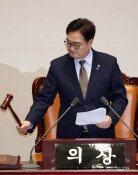[Editorial] Medical Clusters as New Growth Engine
[Editorial] Medical Clusters as New Growth Engine
Posted August. 11, 2009 08:25,
Osong in North Chungcheong Province and Shinseo Innovative Town in Daegu have been selected as the countrys two high-tech medical-industrial clusters. The government through 2038 will invest 5.6 trillion won (4.56 billion dollars) into the two regions, including 1.8 trillion won (1.47 billion dollars) for facility operation and 3.8 trillion won (3.1 billion dollars) for research and development. The money will be used to build assistant drug development centers, general research complexes, including those for developing high-tech medical equipment, and high-tech clinical trial centers. The two sites thus will become the de facto hubs of the domestic medical industry.
Encompassing the medical sector, the biotechnology industry is considered a new growth engine that is expected to follow the boom created by information technology. Due to the worlds rapidly aging population and advances in biotechnology, the global health and medical market is projected to grow from 3.8 trillion won (3.1 billion dollars) in 2005 to 6.3 trillion won (5.13 billion dollars) by 2020. Korean medical technology and equipment are recognized worldwide for their excellent quality, but the sector lacks infrastructure to back it up.
Advanced economies are racing to develop high-tech medical complexes and attract multinational pharmaceutical companies and medical institutions. Houston, Boston and San Diego of the United States, Kobe of Japan, and Singapore have aggressively developed clusters in trying to grab a piece of the burgeoning global medical market. Korea is rather late in the development of its medical industry.
The Korean government plans to complete the complexes by 2012 and continue investing in research and development to develop them into Koreas own versions of Bostons Bio Cluster and Singapores Biopolis. Because Korea is a latecomer, it must aggressively catch up by developing high-tech medical-industrial clusters without fail, and develop them into medical hubs where companies, academia, think tanks and medical institutions jointly conduct cutting-edge research.
The Health, Welfare and Family Affairs Ministry was originally expected to pick one site, but chose two. Critics say politics influenced the governments decision to divide the purported cluster into two. Ten provinces and cities spanning nine regions staged a fierce competition to attract the clusters, which will have a huge impact on provincial economies, including job creation. The government must use wisdom to prevent the projects from being hampered by disputes stemming from the result of the selection process and aftereffects.
For the clusters to succeed, the private sector will contribute 61 percent of the projected investment but must make aggressive investment. If investment is divided into two sites, the resulting impact could be cut in half and project schedules could be delayed. The government needs to increase efficiency by separating the roles of the two clusters.
If the clusters create a synergy effect among innovative drugs, high-tech medical equipment and clinical trials and demonstrate the excellence of Korean medical technology to the world, Koreas bid to attract foreign medical tourists will receive a huge boost.







